|
III. The Gods as Architects
Pyramids,
Platforms, Dolmens and Mounds
As is well known there are literally hundreds of pyramids of various
styles scattered over the Earth, in Europe, Africa, the Middle East
and Far East, Southeast Asia and South Pacific, and in North and
South America.
A few of these sites demonstrating the
different styles are:
- Iraq: The reconstructed
ziggurat-pyramid at Ur, in ancient Sumer.
- Egypt: The step pyramid at Saqqara.
- Egypt: The smooth-walled
pyramids at Giza. Hancock
and Bauval (1996) suggest that the ‘ground plan’ of the
three great pyramids was physically established in 10,500 BC,
but that the pyramids were built around 2,500 BC. This supports
the notion that the pyramid base rock with its underground
chamber was an early AA terminal, and the Sphinx was the
associated landmark easily identified from space.
- Mexico: The highly decorated step pyramids at Chichen-Itza,
Monte Alban, and elsewhere. In the Temple of Inscriptions at
Palenque, a shaft runs from the tomb up to the temple floor,
similar to some of the Egyptian pyramids. There was initially a
40 ft "comb" on the top. Was this an additional identifying
marker?
- Mexico: The unusual elliptical pyramid at Uxmal.
- Mexico: The huge, unexcavated pyramid at Cholula (Fig 4-1), in
the shadow of the volcano, Popocatepetl ("El Popo"). Its ancient
name, Tlachihualtepetl, means "man-made mountain". On
Quetzalcoatl’s pilgrimage his first stop was Cholula, which
means ‘the place of flight’ in Nahuatl.
The huge "Piramide Tepanapa", 200 ft
high and 1300 ft on a side, is the largest ancient pyramid in
the Americas, and possibly the largest in the world. The
earliest construction has been traced to 200 BC. It was covered
with dirt to hide it from the invading Spaniards and a small
shrine was placed at the top, which the Spanish replaced with a
church (Fig 4-1). The small portion which has been excavated
reveals remarkable masonry (Fig 4-2).
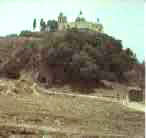
Fig 4-1
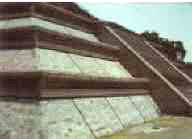
Fig 4-2
- Mexico: Tres Zapotes, an Olmec
site (1300 – 400 BC), was the first adobe-brick pyramid site in
Mesoamerica. (Mystery buffs please note: Before the arrival of
Cortez ALL of the Olmec sites were destroyed, except El Tijin,
which had been abandoned!)
- Mexico: The truncated cone pyramid of Cuicuilco. In 1917
Manuel Gamio, excavating off the road from Mexico City to
Cuernavaca, found an overgrown hill called ‘Cuicuilco’ enveloped
by pre-historic lava streams. It turned out to be an enormous
ancient pyramid or truncated cone with four galleries and
central staircase. It is one of the few remaining round stepped
pyramids.
The base is 370 ft and it is about
60 ft high now, although it was originally much higher.
Archeologist Paul Heinrich reports the age to be 800 to 600 BC,
not 6000 BC as reported by others. (Miller, 2000)
- Mexico: The beautiful miniature pyramid at Cecilia, D.F.
- Mexico: The platform-pyramids at Teotenango, Tenayaca, and
Tula.
- Mexico: The multi-platform style of the Pyramid of the Sun,
Teotihuacan. In his discussion of Teotihuacan, John Michel
(1995) quotes another researcher:
"During the 1970s Hugh Harleston,
Jr …established that ‘the basic unit of measurement at
Teotihuacan was 1.0594 meters, the same unit which
represents the ‘Jewish rod’ of 3.4757 ft., the same unit
which represents the width of the Stonehenge lintels, a
six-millionth part of the earth’s polar radius…’"
- Guatemala: The huge pre-classic
(150 BC-150 ad) Mayan site of El Mirador with its dozens of
pyramids, including the Tigre Pyramid rising 18 stories high,
probably the largest pyramid ever built by the Maya.
- Peru: Moche Temple of the Sun. The earlier Moche built this
temple-pyramid style pyramid from 140 million adobe bricks.
- Peru: Sipan Pyramid. This Moche pyramid-tomb near the town of
Sipan proves that some of the early SA pyramids were tombs, as
in Egypt and Mesoamerica.
- Peru: Pyramids of Cahuachi. A ceremonial site comprised of six
pyramids, the highest being about 70 ft, overlooking a walled
court of 4050 sq yards. (Morrison, 1988). Hadingham (1987)
mentions that the "great temple" was a stepped pyramid. He
quotes Helaine Silverman’s estimate that the period of most
activity at Cahuachi was short lived, about 200 years, and the
site was mysteriously abandoned around 200 ad, along with other
several other important sites.
- Peru: The pyramids of
Tucume.
"Covering over 540 acres and
including 26 major pyramids as well as myriad smaller
structures…first built around 1100 ad by people of the
Lambayeque culture…"
The largest of the adobe brick
pyramids, Huaca Larga, is 2300 ft long, 910 ft wide and 65 ft
high. (Heyerdahl, 1995). Robert Schoch (1999) writes,
"The largest of the pyramids,
called Tucume…was only a little over 200 feet high, but it
contained one-third more volume that the Pyramid of Khufu at
Giza."
- Peru: Huaca del Sol, Moche Valley.
This is a 120 ft high pyramid on the Peruvian north coast. The
1.5 million mud brick pyramid is the largest man-made mound in
SA. Facing Huaca del Sol across the main plaza was a smaller
mound, Huaca del Luna. The site lies at the foot of Cerro
Blanco, an obvious landmark from space for this
ceremonial/feeding center (Hadingham, 1987)
- Bolivia: The Akapana platform-pyramid at
Tiahuanaco. The Bolivian
archaeologists date the site to 1580 BC. The Akapana measures
688 ft on a side and is 49 ft high. "The earthen interior was
shaped like a stepped pyramid and faced with fitted stones."
(Demetrio, 1983)
- Java: Cani Sukuh pyramid, resembling the Mexico pyramid style
(Childress, 1996). Who carried this style across the Pacific?
- Ryukyu Islands: The
Yonaguni underwater pyramid.
This unique step-pyramid-platform, 240 ft long and 90 ft high,
resting 75 ft underwater, has been dated to 8000 BC! (Dopatka,
2000)
- China: The
White Pyramid, near Xi’an.
Hartwig Hausdorf (1998) says there are 90-100 pyramids in China,
near Xi’an, the tallest being about 200 ft. Xi’an incidentally
is the site of the amazing ‘Terracotta Army’ of Qin Shi Huang.
- Polynesia: "modest pyramids" at Tongatabu; a temple-pyramid on
Tahiti; the Langi stepped pyramid-platform at Tauhala (a large
stone, 24 x 7 ft and weighing 30-40 tons, is in the wall).
- Ancient pyramids are also found on Samoa and Java. (Childress,
1996)
- Greece: Pyramid of Hellinikon, near Argos. The author writes,
"…built in the style reminiscent of cyclopean walls…" Its base
is 15 x 13 meters, and the tallest wall still standing it only
14 ft. From the photos it probably would have stood about 10
meters high when completed. Thermoluminescent analysis of the
pyramid in 1997 yielded a construction date of 2720 BC, older
than the archeologists state for the Cheops pyramid! (Tsoukalow,
2000)
- Canary Islands: The
pyramids of Guimar. Thor
Heyerdahl writes,
"…They were painstakingly built
step-pyramids, constructed according to similar principles
as those of Mexico, Peru, and ancient Mesopotamia."
- United States: Monk’s
pyramid-mound at Cahokia, Illinois, a mud brick
platform-pyramid. A large stone wall or room has recently been
discovered inside the mound, but has not been excavated as of
Oct 2000.
- Yonaguni: Situated between the East China Sea and the
Philippine Sea, about 300 miles from Okinawa, is the
island of Yonaguni-Jima. Off
it's coast is a huge apparently manmade (god-made?) monument
about 100 ft below the surface. Its a platform pyramid 600 ft
wide, 90 ft high constructed of precisely hewn megalithic
stones. The pyramid, apparently a part of a ceremonial center,
has been dated to 8000 BC, 5000 years before the oldest pyramid
in Egypt!
The best clue we have that the gods orchestrated the pyramid
building is the tale of Gudea who built the temple-ziggurat at
Lagash (apparently the god Kothar-Hasis was the only one authorized
to design the temples. He was likely the same "Greek divine
craftsman Hepahaestus" who built the temple-abode of Zeus, and the
Egyptian god Thoth).
For Ninurta’s temple at Lagash Gudea was
given elaborate and continuous instructions by the gods. He built a
seven-tier ziggurat, named Eninnu, referring to a ingenious tablet
which gave a plan view and 7 scales – one for each tier (Zecharia
Sitchin describes this story in detail in his
1976 and
1993 books. See also figs 748, 749
of Pritchard, 1969).
Zecharia Sitchin makes an interesting connection with his
statement that the three great pyramids of Giza are at 52 degree,
but the later pyramids collapsed at this angle and were built at
43.5 degrees, and he maintains that the pyramids at Teotihuacan are
also at 43.5 degrees.
Furthermore,
"although the 2nd pyramid at Giza is
shorter than the Great Pyramid, their peaks are at the same
height above sea level because the 2nd one is built on higher
ground; the same holds true at Teotihuacan where the smaller
Pyramid of the Moon is built on ground some thirty feet higher
than the Sun Pyramid, giving their peaks equal height above sea
level."
We should note here also that both the
Great Pyramid at Giza and the Sun Pyramid at
Teotihuacan have a descending shaft
burrowed into the bedrock on which the pyramids were built.
One of the problems in choosing a landing site for a vertical-lift
aircraft is the dust and dirt generated by the exhaust. Before
pyramids were built this problem was apparently minimized by landing
on large rock outcrops.
The problem is better solved however by landing on step pyramids, or
step platforms, since the tiers at each level would effectively
deflect the exhaust (Fig 4-3).
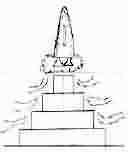
Fig 4-3
Deflection of rocket exhaust
by stepped pyramid design
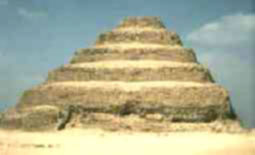
Fig 4-4
Zoser pyramid in Egypt
The ziggurats at Urand Babylon, the
Zoser pyramid in Egypt (Fig 4-4), the Canary Island pyramids, and
most of the Mexican pyramids and South American pyramids, employed
this design.
Interestingly some of the Egyptian pyramids have multiple chambers
which seem to have been built over periods of time, e.g. Sneferu’s
pyramid has an underground chamber, a 2nd chamber near the surface,
and a 3rd chamber up in the pyramid, as if the site was in use
before, possibly long before, the pyramid was erected, probably as a
landing and feeding site.
The chambers of the Great Pyramid also
follow this pattern; the 1st one being deep underground, then the
2nd (‘Queens’) chamber built low in the center of the pyramid, and
the 3rd (‘Kings’) chamber higher up. This pattern suggests that one
goal was to provide continuous and increasing degrees of protection
from above.
The pyramids of Mycerinus, Unas, Teti and most others also had
underground chambers. In fact the pyramids of Mycerinus and some
others did not even have chambers in the pyramids themselves - all
chambers were underground! Obviously this design would make
excellent bomb shelters, and I suspect that the large pyramids, and
any hapless occupants, if they had been located at "ground zero" at
Hiroshima or Nagasaki, would have survived. The pyramidal shape
would have effectively deflected most of the blast wave and
fireball, and the neutron and gamma-ray pulses would have been
attenuated to negligible levels by the stone mass.
Zecharia Sitchin (1985) offers a rather fantastic function for the
pyramids of Giza: that they were built by
the Nefilim, not by
mankind, as part of a guidance grid for "the Tilmun spaceport".
He develops a theory that ties the
pyramids and the "sacred cities" into a guidance and communication
grid for two approach corridors, one west-to-east over Mesopotamia
and one west-to-east over the Sinai.
"Built by the gods (Anunnaki), they
were landmarks and beacons for the spaceport in Sinai, and
existed long before kingship began in Egypt.
"The great pyramid was "…the
mountain by which Utu ascends…".
Regarding the Giza pyramids some
scholars argue that the stones were pulled up long ramps on sleds,
referencing the familiar painting from the tomb of Djehutihotepe of
204 workers moving his 60 ton statute on a sled (Fig 4-5). But this
only proves that this statue was moved on a sled. I am not aware of
a single image or inscription which depict the methods used to
construct the great pyramids.
We simply do not know how it was done.
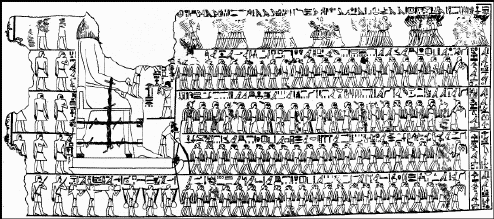
Fig 4-5
Incidentally Mark and Richard Wells
(2000) have discovered an amazing similarity in the alignment and
size of the three stars in Orion's belt and the alignment and size
of the major pyramids at Giza, Egypt; Xi'an, China; Teotihuacan,
Mexico. Don't miss their essay.
So we have pyramids of heights ranging from 30 ft to over 400 ft,
lengths from 100 ft to 2300 ft; some with inner chambers and some
solid throughout; stepped and smooth walled; square, round and
elliptical bases; stone, mud and adobe brick construction; highly
decorated or plain; some topped with small buildings.
From these various styles, sizes, and composition I think we can
conclude that the pyramids had several functions: burial sites,
landmarks, landing sites, feeding stations, bomb shelters, and
ceremonial sites; and there is evidence that many of them served
several functions simultaneously.
But one thing seems certain – the
pyramids, platforms and mounds around the world were places where
the gods and mankind came together.
Back to Contents
The Megalith Builders
Yahweh questions Job:
“Let me ask thee, and answer thou
me: Where wast thou, when the Earth’s foundation I laid out?
Say, if thou knowest science: Who hath measured it, that it be
known? Or who hath stretched a cord upon it? By what were its
platforms wrought? (my emphasis) Who hath cast its Stone of
Corners?”
(Job 38:3-8 as translated
by Sitchin, 1998)
The literature contains many references
to the enormous hewn stones which were used in ancient construction
around the world, a few of which are as follows (See also Cohane,
1977, chapter 12):
- Egypt, The Great Pyramid of Cheops:
“…consists of 2.5 million stones 1 to 40 tons each. It takes a
300 hp diesel engine and hydraulic lifter to pick up a 7 ton
granite slab”.
“The biggest blocks at Giza weighed
200 tons. The biggest blocks at Tiahuanaco weighed 400 tons…
- Egypt, Zoser pyramid complex:
“Mummified bulls were found in stone coffins weighing 80 tons.”
-
Egypt, Aswan quarry:
“The ‘Unfinished Obelisk’ near Aswan still
lies in its quarry, detached on all but its lower side. If it
had been extracted, it would have been 41.75 meters (137 ft)
high with a base about 4.2 meters on each side. The total weight
would have been about 1168 tons, heavier than any piece of stone
ever handled by the ancient Egyptians”.
-
Egypt, Temple of Hatshepsut at Karnak: “…one of the largest
standing obelisks remaining at Karnak. It is 29.5 meters (96.7
ft) high and weighs 323 tons.”
-
Egypt, Karnak:
“The seventh and last of the Karnak obelisks…is
the largest surviving obelisk, with a height of 36 meters.” This
118 ft obelisk was removed to Rome in antiquity and now stands
in the Piazza San Giovanni in Laterano. It was shortened to 32
meters (105 ft) when it was re-erected in the sixteenth century,
and its current weight is 455 tons.” (Fig 5-2).

Fig 5-2
Obelisk at Karnak
- Egypt, Luxor:
“Ramesses II placed
two obelisks before the Luxor Temple, only one of which remains,
the other was taken to Paris. The Luxor obelisk is made of red
granite; it is 25 meters (82 ft) high and weighs 254 tons.”
-
Bolivia, Tiahuanaco and Puma-Punku:
“…stones weigh up to 400
tons…”
“…stones up to 100 tons each, were quarried 10 kilometers away.”
“One block of red sandstone in the platform of the Puma Punku
weighs 131 tons. It had been hauled 10 kilometers.”
-
England, Stonehenge:
“…160 stones, 4-37 tons each.”
“The
‘sarsen’ stones were moved 20 miles from Avebury, some weighing
30 tons and standing 30 ft high.”
-
England, Avebury:
“There were two hundred or so stones in the
circles, the largest of which were over 55 tons, to be dragged a
mile or more from the Downs.”
-
Ireland, Dublin:
“…The capstone of the megalithic tomb at Brenanstown, weighing approximately 67 tons.”
-
Mexico, La Venta:
“…some of the (Olmec) stone “portrait” heads
weighing as much as 25 tons.” “Stones weighing as much as 30
tons were found at Mitla.”
-
Mexico, Quirigua:
“…the largest Mayan stele, at Quirigua,
measuring 10.7 x 1.5 x 1.27 meters, and weighing 65 tons.” “the
site of Quirigua is where the largest monolith in the Maya world
stands. It is the Stella E, weighing 65 tons and standing 35
feet high. It was quarried about three miles away.”
-
Peru, Sacsahuaman: “…a stone 27 ft high and weighing over 300
tons.”
-
Peru, Ollantaytambo: Regarding the six colossal monoliths at
Ollantaytambo,
“The gigantic stone blocks are from eleven to
almost fourteen feet high, average six or more feet in width,
and vary in thickness from about three to over six feet.”
“…some
weighing up to 250 tons.”
“…the giant stone blocks were quarried
on the mountain on the opposite side of the valley. The heavy
blocks of red granite, after they had been quarried, hewed, and
shaped, were then transported from the mountainside, across two
streams, and up to the Ollantaytambo site, carefully raised, put
precisely in place, and finally fused together.”
(Sitchin,
1990). (Notice the phrase "fused together".)
-
Lebanon,
Baalbek:
“…the colossal stones, the Trilithon, each
weighs about 1100 tons; it is a weight no modern piece of
equipment can even come close to lifting and moving.” (Fig 5-3).
“None of today’s machines could move these megaliths. The
largest block is 21 x 4 x 4 meters and the two others are 19.50
x 4 x 4 meters. Together they are 60 meter in length and 960 cu
meters in volume. The blocks were quarried 400 meters distant."
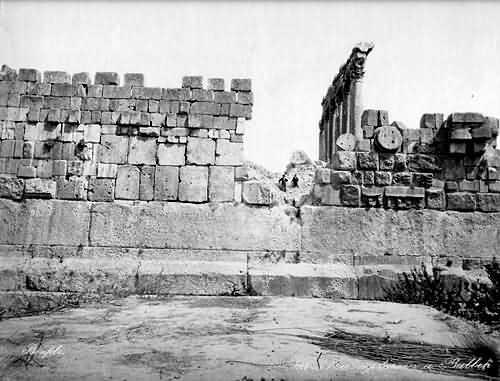
Fig 5-3
Trilithon at Baalbek
“The first of these blocks to the
right (the Trilithon) measures 65’ in length, the second 64’10”,
the third 63’2”. They were all 14’ 6 in height and 12’ in
thickness”.
“…the stone in the quarry, Hajar-el-Hibla ("stone of the
pregnant woman") is 69’ long, 16’ wide, and 13’10” high…this
enormous stone weighs about 1000 tons” (Fig 5-4).
Apparently
this is the largest construction stone in the world.
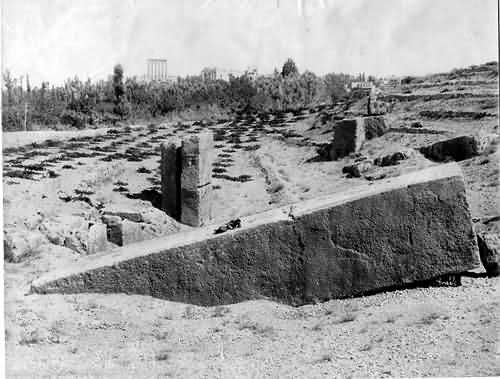
Fig 5-4.
Hajar-el-Hibla at Baalbek
- Israel, Jerusalem, The Temple Mount:
“The stones were cut with such precision that no mortar was
needed to fit them together. Some of these ashlars (columns) are
as much as 35 feet long and weigh up to 70 tons.”
“The Royal Stoa at the southern end of the mount was built in the shape of
a basilica with four rows of 40 columns each, each 50 feet
high…would weigh about 85 tons each.”
“about 60 feet north of
Wilson’s Arch…there are four blocks 11 feet high, one of which
is 42 feet long and 14 feet thick, giving an estimated weight of
1,200,000 pounds…”
-
France, Carnac: “…the 650 foot ‘long mound’ (Er-Grah), and its
relationship to the Grand Menhir monolith, 65 feet tall and
weighing 350 tons (now fallen)…”
-
Malta:
“At Tarxien there are three temples and one Hal-Saflieni,
a rock-cut hypogeum. The temples incorporate stone blocks
weighing up to 24 tons each.”
-
Greece, Mycenae, the ‘Treasury of Atreus’:
“One or the lintels
over the entrance door measures 9x5x1.2, with an estimated
weight of 120 tons.”
“…it is roofed by two enormous slabs, beautifully cut and
polished, of which the inner one measure 3’9” in thickness, and
27.5’ in length on its lower and 29’ on its upper surface; its
breadth is 17’, and it is computed that it weighs approximately
300,000 English pounds.”
-
Easter Island, Rapa Nui: Of the 300 standing statues the highest
is 65 ft; of the 200 unfinished statues in the quarry, one would
have been 164 ft high.
Today, with high strength steel, we are
able to move heavy objects on steel wheels, e.g. a 200 ton autoclave
was moved 750 miles over US western roads on a rig having 112 wheels
and powered by two large diesel tractors. However some things are
too big to be moved on wheels, and instead steel rollers are used.
The 198-foot-high Cape Hatteras
Lighthouse was moved about a half mile during 1999. It weights well
over 1000 tons. To move the lighthouse a compacted gravel road was
built, on which large steel plates were placed. Steel rails were
then set on the road plates in the direction of the move. To
accomplish the move steel roller “dollies” were placed on the rails
and were driven by powerful hydraulic rams.
A total of 400 tons of steel was used
directly under the light for support. The light would be moved a few
feet and then the plates and rails behind it would be unbolted and
moved to the front.
Kiloton objects can also be moved on “tank tracks” which are
essentially steel rollers running on steel tracks.
Also steel cranes have been built which can lift several hundred
tons. A New York engineering corporation has a huge hydraulic crane
which can lift 500 tons, which is used to lift smaller cranes to the
tops of buildings under construction. NASA constructed a crane
having a lifting capacity of 430 tons, which is used to lift the
shuttle during attachment to the fuel tanks.
Its been suggested that the huge stones in place at ancient
megalithic sites were moved around on wooden rollers. I think these
authors are not aware of the relative strength of wood and steel.
While a steel T-beam, mounted vertically with both ends fixed, can
support a load of about 100 tons, a 10 inch diameter wood beam of
the same length can only support about 10 tons.
And if the wood beam is laid down so
that the load is cross-grain rather than end-on, it will splinter
under a much smaller load. Furthermore even if they don't splinter
they will deform under the load and will slide instead of roll; this
happened when 20 people tried to move a replica of one of the
statues on Easter Island, and it only weighed 9 tons!
So can we really imagine a group of
prehistoric people sliding the 1000 ton blocks at
Baalbek? Some
Egyptologists suggest that the huge obelisks were moved on wooden
rollers but not a single one has ever been found. Clearly it’s just
nonsense to maintain that these stones were moved on wooden rollers.
So, when we consider the kiloton stones used at ancient megalithic
sites, especially the monsters at Baalbek, I see three
possibilities:
-
The first is that a technology comparable to our own existed at that
time, employing high strength metal alloys, hydraulics and powerful
engines. However, such a technology would involve the use of many
materials, including gold and ceramics, which would last many
millennia, and I am not aware of any reports of discoveries of any
such artifacts.
Additionally, since this technology
existed all over the Earth, this possibility requires the difficult
assumption that the members of this entire civilization disappeared,
or at least “forgot” the technology, at about the same time, or in a
worldwide conspiracy, disposed of all of the tools. This scenario
seems highly unlikely.
-
There are a few references to a second possibility which take us
into the psi world - that the stones were moved by beings having the
ability to control the local gravitational field:
-
Giza, Egypt: “Then said Pharaoh,
‘Where lies the papyrus on which Imhotep wrote the words of
power that went to the building of the pyramid for Zoser, yes
and for that of Seneferu my father also…The words of power can
be found and spoken by none but he-and if he speaks them three
great pyramids shall rise at Giza and stand there forever. But
if he speaks them not, all that you build, and your son builds
and your son’s son after him shall fall and crumble away and
become as the sands of the desert.’”(Green, 1967). At his "Giza
Oracle" site Patrick Cooke presents a compelling argument that
the Great Pyramid was not built by ancient Egyptians.
-
Uxmal, Mexico: “…construction work was easy for them…all they
had to do was whistle and the heavy rocks would move into
place.”
-
Tiahuanaco, Bolivia: “…(the stones were) carried through the air
to the sound of a trumpet”.
-
Giza, Egypt: “…a magician was said to have raised into the air a
huge vault of stone 200 cubits long and 50 cubits broad”.
(Hancock, 1995).
However with our current level of
technology, ideas concerning anti-gravity and levitation take us
into the realm of the supernatural, and so are out-of-bounds in
these pages.
-
The third possibility is that aircraft
and cables were available at that time which had the power and
strength to lift and move the stones.
Of course we do not know for sure how these incredibly heavy stones
were quarried, moved, and assembled, and short of a revelation, will
likely never know. But we do know that even the heaviest
construction today is not done with kiloton stones; it’s difficult,
slow and expensive. Logically the only reason for the ancients to
build with such huge stones is because it was easy for them to do
so.
Consider Baalbek in Lebanon where we find a huge platform which
underlies, and predates, the ruins of the magnificent Roman temple
of Jupiter. It contains the largest stones ever used in
construction. How was it built? And by whom?
Here are some clues:
- Michel Alouf (1999) discusses the
many theories concerning the builders of the pre-roman portions
of the site. He came to the conclusion that it was the temple
Baalath built by Solomon, based on the following biblical
passage (I Kings, IX; 17-19):
“And Solomon built Gezer and
Beth-Horon, the lower, and Baalath and Tadmor (Palmyra) in
the wilderness, in the land, and all the cities of store
that Solomon had, and cities for his chariots, and cities
for his horsemen, and that which Solomon desired to build in
Jerusalem, and in Lebanon, and in all the land of his
dominion.”
- Childress (2000) mentions
the Kebra Negast, the spiritual guide of the Ethiopians, which says
that Solomon had a flying vehicle; also that there are hilltops
in Pakistan and Iran where Solomon is believed to have landed.
- By the tradition of the ancient Jews,
Jehovah was not the only
god in the universe, he was the “only god of this particular
people”; and although by the act of the covenant the Israelites
had committed themselves to the rule of Jehovah’s law, King
Solomon (950 BC) had permitted the worship, apparently even in
Jerusalem, of a rival god, Baal, whose main temple was at
Baalbek (Baalath).
- Near the Golden Gate (Jerusalem) is a small mosque, the “Kurst
Suleiman”. Here legend tells us that, “King Solomon sat watching
the Jann and Genii laboring to build his great monuments in
Jerusalem, Baalbek, and Palmyra.” (Cornfeld,1972) (Jann were a
type of Persian Genii, or "Genius", who had the annoying habit
of stealing cows – to eat, I suppose).
- Throughout the ancient Near East we find images of one or more
people flying in “winged discs”. And we find “genie”, also
called “bird-men” by scholars, who are represented as powerful
humans with wings (Fig 5-5), and sometimes with the face of an
Eagle, and called "eagle-men". Virginia Marin (www.Suite101.com)
writes that Genie, or geniuses, were “…all-powerful. They had
great natural and inventive ability. They were smart and
possessed great mental capacity…”

Fig 5-5
I conclude this page by speculating that
the stones were moved by being suspended from powerful aircraft
operated by the AA “geniuses”.
Puedo estar loco, but the stones are there!
Back to Contents
Master Masons
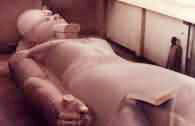 Yahweh
questions Job: Yahweh
questions Job:
“Let me ask thee, and answer thou
me: Where wast thou, when the Earth’s foundation I laid out?
Say, if thou knowest science: Who hath measured it, that it be
known? Or who hath stretched a cord upon it? By what were its
platforms wrought? Who hath cast its Stone of Corners?”
(Job 38:3-8 as translated
by Sitchin, 1998)
A unique characteristic of many of the
megalithic sites is the polygonal stones which were used, the “Stone
of Corners”.
At Sacsahuaman, above Cuzco, Peru there is the stone of
Hatun Rumiyoc, a huge polygonal stone with 12 corners, which
interlocks perfectly with adjacent stones. Polygonal stonework was
used at several sites in Peru (Figs 6-1,2 ), Greece (Fig 6-3),
Lebanon (Fig 6-4), Turkey, Egypt and Bolivia, and Easter Island,
among others. Also near the base of the Cheops
Pyramid.
Polygonal Masonry
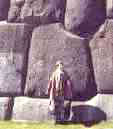  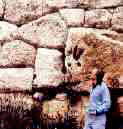 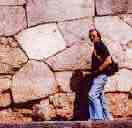
PERU
Delphi, Greece
Baalbek, Lebanon
Fig 6-1
Fig 6-2
Fig 6-3 Fig 6-4
In addition to being exquisitely
hewn and fitted, some of the stones were actually fused
together.
I have examined the fused joints in the Coricancha in
Cuzco (Fig 6-5, sometimes spelled Koricancha, which in Quechua
means "the corral of gold"), at Ollantaytambo in Peru, inside
the Great Pyramid of Egypt (Fig 6-6) (I was astonished at these
joints), and at Delphi in Greece.
Regarding Ollantaytambo Sitchin (1990) writes that the gigantic blocks were “…carefully
raised, put precisely in place, and finally fused together.”
Fused Masonry
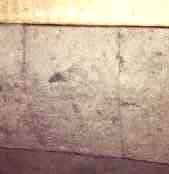
Fig 6-5
Coricancha, Peru
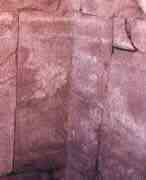
Fig 6-6
Great Pyramid, Egypt
Another skill of the master mason
was the use of single blocks carved as corners, in Egypt (Fig
6-7), and Peru, among others (see also Zink, 1979)
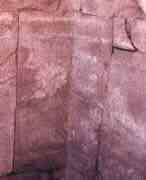
Fig 6-7
One-piece corner
So let's speculate about the
technique of the master masons.
I’m inclined to think that the
shaping and fusing of the polygonal stones might have been
accomplished as follows: Two irregular stones are leaned against
each other (Fig. 6-8a). A high temperature beam (acetylene or
electric torch, laser, ion beam?) is passed back and forth
across the contact point A of the stones, resulting in the first
fused joint (b); a third stone is placed on top of the first two
and high temperature shaving is performed at the contact points
B and C (c), resulting in three fused joints (d).
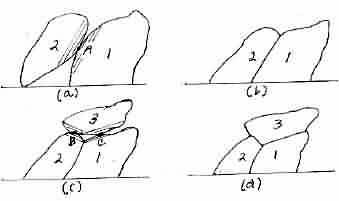
Fig 6-8
Illustrating the joining and fusing of polygonal stones
This scenario of course requires
that we accept that the builders of these ancient, and mostly
prehistoric, structures could easily pick up kiloton stones and
place them on top of each other and could produce a beam
sufficiently hot to fuse them together.
I think they could.
Back to Contents
Desert Artists
"Reality must take precedence over
public relations, for nature cannot be fooled"
– Richard Feynman
"Only within recent years, since the development of universal
communications allowed us to compare the antiquities of our own
countries with those of others, have we been able to see the
extent of the vast ruin within which we all live. If we ignore
all alterations to the landscape arising within the last three
thousand years and consider the world as it must have looked in
prehistoric times, the pattern that emerges is one so
incompatible with our idea of civilization that it is easy
entirely to miss its significance.
For what we find is this: A great
scientific instrument lies sprawled over the entire surface of
the globe. At some period, thousands of years ago, almost every
corner of the world was visited by people with a particular task
to accomplish.
With the help of some remarkable
power, by which they could cut and raise enormous blocks of
stone, these men created vast astronomical instruments, circles
of erect pillars, pyramids, underground tunnels, cyclopean stone
platforms, all linked together by a network of tracks and
alignments, whose course from horizon to horizon was marked by
stones, mounds and earthworks."
- John Michell(1995)
In 1975 I flew over the Nazca plain in
Peru, since the figures and patterns can only be recognized from the
air, along with a small intrepid group of fellow mystery-mongers.
For me
the Nazca lines represent the most persuasive piece of
physical evidence in support of the Ancient Astronaut (AA)
hypothesis. Although hundreds of writers have generated thousands of
pages about the lines and figures, I have not been able to find a
sensible explanation of how they were made, or by whom, or for what
purpose. It seems obvious that the lines were made from the air.
They could have been used as landmarks
to be seen from space, or perhaps the AA’s were simply venting their
artistic impulse on a convenient giant "etch-a-sketch"; however what
I feel is most likely is that they used the Nazca plain to test and
calibrate the instrument which they used throughout South America,
and perhaps elsewhere on Earth, to delineate "roads" and radial "ceques"
linking important sites. I think that the lines were probably
created by using an instrument which could sweep away shallow paths
of varying widths.
I think "the sweeper" was probably
something as simple as a high-pressure water stream operating in
much the same way as we use a garden hose to wash gravel from our
driveways. Certainly, with the Nazca plain bordering on the sea,
there would have been a plentiful water supply.
Some of the less precise drawings suggest that the sweeper might
have been a gimbaled device which was guided by hand, similar to the
machine-gun mounts on old bombers; however the great precision of
many of the figures suggests that it more likely was a computerized
device which used pre-stored images, such as modern computer driven
routers. For these drawings the aircraft would have had to hover
quite stably.
Here's how I think they were made:
The 2800 foot long "Needle and
Thread" drawing (Fig 3-1, adapted from Discover Magazine,
December 2000) begins at the bottom of the figure as a wide
beam; the beam is focused to a line as it moves up the "needle";
the artist then uses a oscillatory motion to delineate the
borders of a plateau; and ends up drawing a spiral, a common
motif at ancient sites (perhaps that’s his signature telling us
he is from the galaxy, which also happens to have the shape of a
gigantic spiral!)
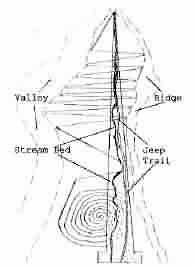
Fig 3-1. "Needle
and Thread" Image, Nazca, Peru
Although most of the figures were simply
outlined with narrow lines, the variable width feature of the
sweeper, as one can also do with the nozzle of a water hose,
permitted the drawing of "filled-in" figures.
The 140 foot long spider (Fig3-2) is one of the best known Nazca
figures. The lines which extend from the rightmost hind leg of the
spider establish that the drawing begins at this point. The entrance
line, the parallel line to the right, started with a broad beam
which was focused to a line, and the hindquarters of the insect were
drawn first.
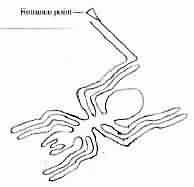
Fig 3-2. The "Spider"
Most of the other animal figures were
drawn in this same manner, with an entrance line, an continuous line
sketch of the animal, and an exit line parallel to the entrance
line. In Fig 3-3 the entrance-exit line-pair join the "hummingbird"
at the beak.
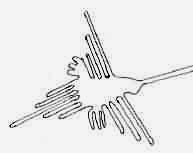
Fig 3-3. The
"Hummingbird"
The "Trident of Paracas", a 600 ft high
drawing over the bay of Paracas demonstrates that the beam power of
the sweeper could be adjusted to provide a much deeper excavation
than was used elsewhere; also the furrows of the spiral figure at
Nazca were reported to be "about a foot deep". Incidentally the
Trident is the largest petroglyph in south America.
Zecharia Sitchin
(1990) makes a rather convincing argument that the Trident of Paracas was the symbol of the Sumerian god Adad, or ISH.KUR ("He of
the far mountains") who was in charge of mining in SA. His other
epithet was ZABAR DIB.BA ("He who bronze obtains and divides")
Apparently the AA’s sweeper helped the Incas create their remarkable
25,000 mile "road" system.
Hadingham (1987) relates that,
"Along the north coast…several
sections of Inca roads run for 25 miles or more with scarcely
any visible deviation. The major coastal artery, in particular,
often ignores minor geographic obstacles, passing straight over
rocky hills rather than curving around them."
For other references on the Nazca lines
see Isbella (1978), McIntyre (1978), Hadingham (1987), Morrison
(1988), Von Daniken (1998)
Although the Nazca lines are the most famous, similar lines have
been reported in Bolivia, the USA, Chile, and as "ley" lines in
Great Britain.
Other huge ground drawings can be found on the 2000 ft high Atacama
Desert in Chili, about 600 mile south of Nazca. The desert is
literally covered, for many miles, with "geo-glyphs". Together they
constitute the "zoo of the Atacama", immense stylized figures.
Traveling another 250 miles south, in the region of Tarapaca
province, on a mountain called Cerro Unitas, we find the "giant", a
huge (600 ft) ground figure with "antennae" radiating from the side
and top of it's head.
The drawing,
"cannot be recognized from the
ground since it wraps up over the crest of the mountain."
(Clarke,
1982)
This I take to be hard evidence that these figures were
created from the air. It’s location next to the "lone mountain" also
suggests that it was a beacon. It is the largest known ground
drawing of a stylized figure.
Zecharia Sitchin (1980) writes about the 30th parallel, reporting
that on this line lie the Tilmun site and the "sacred cites" of
Giza-Heliopolis (Egypt), Eridu (Mesopotamia), Persepolis (Persia),
Harappa (Indus valley), and Lhasa (Tibet). He further suggests that
"Indeed, were we to study all these sites, all of Earth would
probably be encompassed."
The Nazca desert - a testing and calibration site for the devices
used to mark the Earth? by AAs? from the air?
I think so!
Back to Contents
Back to Ancient and Modern Megaliths
IV. The Technology of the Gods
The Gods and Their
Flying Machines
The major attribute of the gods is that they could fly. Here are a
few clues:
- When flying Quetzalcoatl appeared
to the ancient Mexicans as a feathered serpent:
“…first it flies, quite high up,
well up it goes, and it just descends…”.
And when it flies or descends a
great wind blows. Wherever it goes, it flies”
(Baldwin, 1998).
Don't you wonder what kind of aircraft might appear to the
natives as a “plumed serpent” accompanied by a “great wind”?
- “…there appeared a chariot of fire, and horses of fire, and
parted them both asunder; and Elijah went up by a whirlwind into
heaven.”
(2 Kings 2:11).
- “And Jehovah was going before them by day in a pillar of
cloud, to lead them in the way, and by night in a pillar of
fire, to give light to them, to go by day and by night…”
(Exo 13:21).
-
Yahweh lands on Mt Sinai.
“…And on the third day, it being
morning, it happened. There were thunders and lightnings,
and a heavy cloud upon the mountain, and the sound of a
ram’s horn, very strong! And all the people of the camp
trembled… And mountain of Sinai was smoking, all of it,
because Jehovah came down on it in fire. And it’s smoke went
up like the smoke of a furnace; and the mountain quaked
exceedingly…”
(Exodus 19:16-18).
“…And the spirit lifted me up, and I heard behind me the sound of a great
tumult, saying, Blessed be the glory of Jehovah from his
place; and the sound of the wings of the living creatures
touching each other to the other; and the sound of the
wheels along with them; and the sound of a great tumult…”
(Ezekiel 3:12).
- Jehovah comes down on the high
places with a great heat:
“For behold, Jehovah is coming
out of his place, and will come down and walk on the high
places of the earth. And the mountains shall melt under him,
and the valleys shall cleave themselves as wax before the
fire, as waters poured out on a steep place…”
(Micah 1:3-4).
- A reference to flying gods in the
Mahabharata:
“The gods, in cloud-borne
chariots…bright celestial cars in concourse sailed upon the
cloudless sky.”
(Sitchin, 1985).
- Sitchin (1985) also mentions the
flying Maruts:
“…loud roaring as the winds make
the mountains rock and reel…(as they) lift themselves
aloft…these verily wondrous, red of hue, speed on their
course with a roar over the ridges of the sky…and spread
themselves with beams of light…bright, celestial, with
lightning in their hands and helmets of gold upon their
heads.”
- Egyptian King Pepi ascends:
“As an imperishable star; Flies
who flies! He flies away from you, O men! He is no longer
upon earth; he is in the sky! He rushes at the sky like a
heron. He has kissed the sky like a falcon. He has leapt
skyward like a grasshopper.”
(Frankfort, 1948).
- An angelic messenger announces to
Manoah about the birth of Samson to his wife, and who, after
telling Manoah that his name is secret,
“…ascends in a flame of fire
from the altar.”
(Judges 13:2-15).
- Naymlap, the leading god of the
Indians of Ecuador, was,
“taken heavenward by the god of
the speaking stone”
(Sitchin, 1990).
- Von Daniken (1982) states that the
“fiery heavenly chariots”, described by Enoch and Elijah are
also found in Buddhist (Padmasambhava) and Hindu (Ardjuna)
mythology. Apparently every child in India is well aware of
ancient flying gods and their aircraft, which they called
Vimanas.
- In the Sumerian tale of Nergal and Ereshkigal (Pritchard,
1975), there are hints that there were periods when the gods
were not able to travel from one location to another, perhaps
because their orbital positions or the planetary alignments were
not favorable:
Anu opened his mouth to say to
Kaka:
I will send thee, Kaka, to the
Land of no Return,
To Ereshkigal…thou shalt say:
"‘Thou art not able to come up,
In thy year thou canst not ascend to our presence,
And we cannot go down,
In our month we cannot descend to thy presence…"
Probably the most familiar description
of the AA’s aircraft (possibly spacecraft) is in the biblical book
of Ezekiel. It is a very convincing description by a very astute
observer. From this description former NASA engineer J. F. Blumrich
designed and patented his impression of the vehicle (Blumrich, 1974)
(Fig 7-1).
A small cockpit, where Ezekiel observed
the "Lord", rested atop the body of the vehicle.
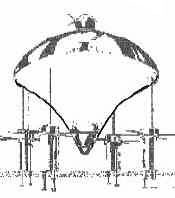
Fig 7-1.
The body, which Ezekiel called the
"fiery firmament", terminated in a single main engine. Attached to
the body were four helicopter engines and blades, which enabled the
vehicle to land vertically without using the main engine, which
would have either covered poor Ezekiel with rubble or blown him
away!
Not so well known, and more interesting in my opinion, is the tale
of the “Divine Throne-Chariot” from the
Dead Sea Scrolls (Vermes,
1962). The introduction to the piece reads:
“The Divine Throne-Chariot draws its
inspiration from Ezekiel(1:10) and is related to the Book of
Revelation. It depicts the appearance and movement of the
Merkabah, the divine Chariot supported and drawn by the
cherubim, which is at the same time a throne and a vehicle. The
‘small voice’ of blessing is drawn from 1 Kings 19:112: it was
in a ‘small still voice’ that God manifested himself to Elijah.
In our Qumran text this voice is uttered by the cherubim and it
is interesting to note that although the Bible does not define
the source of the voice, the ancient Aramaic translation of 12
Kings (Targum of Jonathan) ascribes it to angelic beings called
‘they who bless silently.’”
“The Throne-Chariot was a central subject of meditation in
ancient as well as in medieval Jewish esotericism and mysticism,
but the guardians of Rabbinic orthodoxy tended to discourage
such speculation. The liturgical use of Ezekiel’s chapter on the
Chariot is expressly forbidden in the Misnah; it even lays down
that no wise man is to share his understanding of the Merkabah
with a person less enlightened than himself…”
Not being a "wise man" I guess I'm free
to share my speculation regarding the Merkabah. Of course the
ancient Hebrews did not have the words to describe the technology
which they were observing; regardless Ezekiel did quite an
impressive job with the words available to him.
The description of the vehicle in operation, excerpted from Vermes
by Barnstone (1984) reads:
“…and the cherubim utter blessings.
And as they rise up, there is a divine small voice and loud
praise; there is a divine small voice as they fold their wings.
“The cherubim bless the image of the Throne-Chariot above the
firmament, and they praise the majesty of the fiery firmament
beneath the seat of his glory. And between the turning wheels
angels of holiness come and go, as it were a fiery vision of
most holy spirits; and about them flow seeming rivulets of fire,
like gleaming bronze, a radiance of many gorgeous colors, of
marvelous pigments magnificently mingled. The spirits of the
Living God move perpetually with the glory of the wonderful
Chariot.
“The small voice of the blessing accompanies the tumult as they
depart, and on the path of their return they worship the Holy
One. Ascending, they rise marvelously; settling, they stay
still. The sound of joyful praise is silenced and there is a
small voice of blessing in all the camp of God.”
Here
it is again with my “interpretations”
in parenthesis:
“…and the cherubim (and the objects
with wings - the helicopters) utter blessings (make a soft sound
resembling prayer). And as they rise up (as the helicopter
blades rise into place), there is a divine small voice (the
blades make a swishing sound in the air) and loud praise (along
with the loud noise of the engine); there is a divine small
voice as they fold their wings (when the main engine is stopped
only the swishing sound of the blades is heard as they drop down
and stop).
“The cherubim (The helicopters) bless the image of the
Throne-Chariot above the firmament (make a soft sound like
prayer), and they praise the majesty (and they speak louder, and
in amazement, about the brightness) of the fiery firmament
beneath the seat of his glory (of the glowing, idling engine
under the main body of the aircraft).
And between the turning wheels
(between the helicopter’s blades), angels of holiness come and
go (wispy changing patterns), as it were a fiery vision of most
holy spirits (of flames and vapors from the main engine); and
about them flow seeming rivulets of fire, like gleaming bronze,
a radiance of many gorgeous colors, of marvelous pigments
magnificently mingled (the exhaust from the helicopter engines
mingled with the multi-colored exhaust from the main engine).
The spirits (the helicopters) of the
Living God move perpetually with the glory (always move with the
flaming exhaust) of the wonderful Chariot (of the wonderful
vehicle).
“The small voice of the blessing (the soft sound of the blades)
accompanies the tumult (accompanies the roar of the main engine)
as they depart, and on the path of their return they worship
(they make a loud noise) the Holy One (the god-pilot).
Ascending, they rise marvelously (the blades ascend quickly);
settling, they stay still (the blades drop down and stop,).
The sound of joyful praise is
silenced (the loud noise of the main engine ceases) and there is
a small voice of blessing (the helicopter blades slow and drop
down) in all the camp of God.”
I do not think there is a better
description of Ezekiel’s “spaceship”!
Another interesting tale is that of Elijah meeting the Lord.
In I
Kings 19:11-12,
Yahweh
makes himself known to Elijah (Eli-yahu):
“And, behold, the Lord passed by,
and a great and strong wind rent the mountains, and brake in
pieces the rocks before the earthquake; but the Lord was not in
the wind: and after the wind an earthquake; but the Lord was not
in the earthquake; and after the earthquake a fire; but the Lord
was not in the fire; and after the fire a still small voice.”
My translation: As the spacecraft
approaches the exhaust was first perceived as a powerful wind; as it
descended on the mountain the engine caused the earth under it to
vibrate; the engine’s fiery exhaust then came into Elijah’s view;
finally, the main engines are stopped and only the sound of the
helicopter blades is heard as they slow and stop.
Zecharia Sitchin (1998) gives an interesting description of Elijah’s
ascent to heaven.
This apparently was also the time when Ezekiel
wrote of his experiences with the Lord’s aircraft - about 592 BC:
“…a chariot of fire, and horses of
fire, came. And they separated between them both (Elijah and
Elisha), and Elijah went up in a tempest to Heaven. And Elisha
was watching, and he was crying ‘My father, my father! the
chariot of Israel and its Horsemen!’ And he did not see him
again…”.
(2 Kings 2:11).
If your language did not include the
words aircraft, or rocket, or spaceship, or any other thing that
could carry men through the air, what could you possibly call it but
a "chariot"? And it seems clear that some of them were what we now
call VTOL (vertical take-off and landing) aircraft.
So I am left with no doubt that the AAs possessed the technology to
come to Earth in spacecraft, and to move about the Earth in various
kinds of aircraft which did not require runways.
Back to Contents
Ancient Nuclear Warfare
“We turned the switch, saw the
flashes, watched for ten minutes, then turned everything off and
went home. That night I knew the world was headed for sorrow”
– Physicist Leo Szilard,
atomic bomb builder
“(It was) a single projectile, charged with all the power of the
Universe. An incandescent column of smoke and flame, as bright
as the thousand suns, rose in all its splendor…it was an unknown
weapon...which reduced to ashes the entire race of the Vrishnis
and the Andhakas…the corpses were so burned as to be
unrecognizable. The hair and nails fellout; pottery broke
without apparent cause, and the birds turned white…after a few
hours all foodstuffs were infected…”
– The Mahabharata.
During the first Egyptian “pyramid war”,
between Horus and Seth, Horus strikes:
“…(and he) let loose against them a
storm which they could neither see with their eyes, nor hear
with their ears. It brought death to all of them in a single
moment…”
(Sitchin, 1985)
This sounds to me like the gamma-ray and
neutron pulse from a sub-kiloton nuclear weapon, which has no
fireball and the nuclear radiation extends far beyond the blast
wave.
Zeus battles the Titans:
“The hot vapor lapped around the
Titans, of Gaea born, flame unspeakable rose bright to the upper
air. The Flashing glare of the Thunder-Stone, its lightning,
blinded their eyes-so strong it was. Astounding heat seized
Chaos…It seemed as if Earth and wide Heaven above had come
together, a mighty crash, as though Earth was hurled to ruin.
Also were the winds brought rumbling, earthquake and dust storm,
thunder and lightning.”
(Sitchin, 1985).
I would guess that this was a large
nuclear weapon which was detonated on or close to the ground, thus
producing a large mushroom cloud.
Zeus conquering Thyphon:
“A flame shot forth from the
stricken lord in the dim, rugged, secluded valley of the Mount,
when he was smitten. A great part of huge earth was scorched by
the terrible vapor, melting as tin melts when heated by man’s
art…in the glow of a blazing fire did the earth melt down.”
(Sitchin, 1985).
Biblical references to
nuclear warfare:
- The destruction of Sodom and
Gomorrah:
“…(Abraham) looked toward Sodom and Gomorrah…and he beheld and
saw a smoke rising from the earth, as the smoke of a furnace.”
(Gen 18:27).
- “…and the Lord sent thunder and hail, and the fire ran along
upon the ground; and the Lord rained hail upon the land of
Egypt.”
– Exodus 9:23
“And it came to pass, as they fled from before Israel, and were
in the going down to Bethhoron, that the Lord cast down great
stones from heaven upon them unto Azekah, and they died: they
were more which died with hailstones than they whom the children
of Israel slew with the sword.”
– Joshua 10:11
“And the fire of God came down from heaven, and consumed him and
his fifty.”
– 2 Kings 1:12
-“Thou shalt make them as a fiery oven in the time of thine
anger: the Lord shall swallow them up in his wrath, and the fire
shall devour them.”
– Psalms 21:9
“A fire goeth before him, and burneth up his enemies round
about.”
– Psalms 97:3
“Thou shalt be visited of
the Lord of hosts with thunder, and with earthquake, and great
noise, with storm and tempest, and the flame of devouring fire.”
– Isaiah 29:6
There are many other clues regarding
nuclear warfare. Childress (2000) discusses ancient atomic warfare,
first Hattusas (Bogazkoy) in Turkey where “parts of the city are
vitrified, and the walls of rock are partly melted.”
He then discusses Sodom and Gomorrah and
compares them with Hiroshima and Nagasaki. He thinks Sodom,
Gomorrah, Zoar, Admah and Zeboiim (Gen. 14:2) were destroyed,
creating the Dead Sea.
He quotes L.M.Lewis, “Footprints on the Sands
of Time”, who argues for atomic explosions.
And he quotes from the Mahabharata an
excellent description of an atomic battle in which Arjuna is given a
“celestial weapon” which he cannot use against humans “for it might
destroy the world”, but he could use it against “any foe who is not
human.”
From the Mahabharata, as quoted by Charles Berlitz (1972), is
probably the best description of
ancient atomic warfare one can
find:
“…(it was) a single projectile,
charged with all the power of the Universe. An incandescent
column of smoke and flame, as bright as the thousand suns, rose
in all its splendor…it was an unknown weapon, and iron
thunderbolt, a gigantic messenger of death, which reduced to
ashes the entire race of the Vrishnis and the Andhakas…the
corpses were so burned as to be unrecognizable. The hair and
nails fell out; pottery broke without apparent cause, and the
birds turned white…after a few hours all foodstuffs were
infected…to escape from this fire the soldiers threw themselves
in streams to wash themselves and their equipment.”
Steinhauser (1975) relates a story from
the Ramayana:
“…when the god Rama was threatened
by a ‘army of monkeys’ (men or robots?) he put a ‘magic arrow’
into action. This produces a flash of lighting ‘stronger than
the heat from a hundred thousand suns’, turning everything to
dust. The hair of survivors falls out, their nails disintegrate.
We know of such magic weapons from Sodom and Gomorrah, and from
Hiroshima and Nagasaki.”
Mohenjo-Daro and Harappa, Pakistan:
David Davenport (1996), who spent 12 years studying ancient Hindu
scripts and evidence at the ancient site of Mohenjo-Daro, declared
in 1996 that the city was instantly destroyed 2,000 years BC.
The city ruins reveal the explosion’s
epicenter which measures 50 yards wide. At that location everything
was crystallized, fused or melted. Sixty yards from the center the
bricks were melted on one side indicating a blast… the horrible
mysterious event of 4000 years ago was recorded in the Mahabharata.
According to that text,
“white hot smoke that was a thousand
times brighter than the sun rose in infinite brilliance and
reduced the city to ashes. Water boiled…horses and war chariots
were burned by the thousands…the corpses of the fallen were
mutilated by the terrible heat so that they no longer looked
like human beings…”
From one of the oldest chronicles of
India... the
Book of Dzyan:
"Separation did not bring peace to
these people and finally their anger reached a point where the
ruler of the original city took with him a small number of his
warriors and they rose into the air in a huge shining metal
vessel. While they were many leagues from the city of their
enemies, they launched a great shining lance that rode on a beam
of light. It burst apart in the city of their enemies with a
great ball of flame that shot up to the heavens, almost to the
stars.
All those who were in the city were
horribly burned and even those who were not in the city - but
nearby - were burned also. Those who looked upon the lance and
the ball of fire were blinded forever afterward. Those who
entered the city on foot became ill and died. Even the dust of
the city was poisoned, as were the rivers that flowed through
it. Men dared not go near it, and it gradually crumbled into
dust and was forgotten by men. When the leader saw what he had
done to his own people he retired to his palace and refused to
see anyone.
Then he gathered about him those
warriors who remained, and their wives and children, and they
entered their vessels and rose one by one into the sky and
sailed away. Nor did they return."
Childress (1999) also presents sketches
of the Citadel of Mohenjo-Daro and a discussion of its destruction
by nuclear explosion. Harappa and Mohenjo-Daro were the main cites
of the “Harappa Culture” of the Indus Valley, an amazingly uniform
and advanced urban civilization existing between 2500 and 1500 BC,
the beginnings of which remain obscure.
About Parshaspur near Srinagar, Kashmir, David Childress (2000)
states,
“It is a scene of total destruction;
huge blocks of stone are scattered about a wide area giving the
impression of explosive annihilation.”
Zecharia Sitchin (1985) devotes an
entire chapter to a discussion of nuclear warfare in ancient times
in Mesopotamia and the Sinai peninsula. In this book he also
suggests the destruction of the Sinai “space facilities” by nuclear
weapons.
He offers as evidence,
“…the immense cavity in the center
of the Sinai and the resulting fracture lines (see figure), the
vast surrounding flat area covered with blackened stones, traces
of radiation south of the Dead Sea, the new extent and shape of
the Dead Sea – is still there, four thousand years later”.
He maintains that the radioactive
fallout from this operation wiped out the area around Sumer for a
period of 70 years, until 1953 BC.
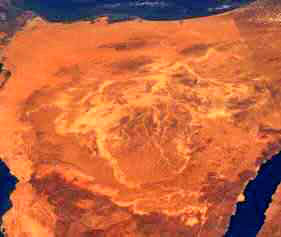
So did the gods use nuclear weapons in
their struggles with each other and with mankind?
You be the judge!
Back to Contents
The Biotechnology of the
Gods
“There are 193 species of monkeys
and apes, 192 of them are covered with hair. The exception is a
naked ape self-named Homo Sapiens”
– Desmond Morris
“It is difficult to say what is impossible – for the dream of
yesterday is the hope of today and the reality of tomorrow”
– Robert Goddard
Tales from various sources suggest that
the gods possessed an advanced knowledge of biology many millennia
ago:
- The Egyptian god Thoth helped
Isis, the wife of Osiris, to extract from the dismembered Osiris
the semen with which Isis was impregnated to bear Horus.
- “The Telleriano-Remensis and Florentine codices declare that
Quetzalcoatl, as great artificer, ‘formed’ and ‘molded’ the
first human beings in his image, and that only he - and no other
god - ‘had a human body’.”
(Baldwin, 1998).
- “Before I (the Lord) formed you (Jeremiah) in the belly I knew
you; and before you came out of the womb I set you apart…”
(Green, Jay, 1986, Jeremiah 1:5).
- “…‘though it is said that in truth Zeus, King of the Gods,
whom you call Amen-Ra, was her father’. Seti nodded when he
heard this and murmured, ‘Even as Amen-Ra was the father of
Hatshepsut. Yes, the gods can indeed be the fathers of the
spirits that dwell in the bodies of kings and queens’.”
(Green,
Roger, 1967).
- In the tale of the birth of Samson, Manoah’s wife, who was
barren, was visited by “the Angel of Jehovah” who said,
“Behold now you are barren and
have not borne. But you shall conceive and bear a son…(who
shall be)…a Nazirite to God from the womb”
(Green, Jay,
1986, Judges 13:2-14)
(Nazirite: Endowed with special
psychic or physical qualities to be used in God’s service).
- “The god Citlaltonac sent an
ambassador to see the virgin Chimalma…The god told her that she
was to conceive a son, which she did soon after…”
(Fernandez,
1982).
- Concerning the birth of the Toltec god Huitzilopochtli:
“…a
woman called Coatlicue, who was charged with keeping clean a
temple on the Cerro de Coatepec, near Tula, was sweeping the
building when she saw a beautiful ball of feathers drop from the
sky, and put it away in her bosom. When she had finished her
work, and tried to find the feather ball, it was no longer
there, it had disappeared. At that same moment she became
pregnant, although she had been a widow for many years.”
(Demetrio, 1983).
- In his discussion of the Sumerian story of the creation of The
Adam (" the earthling") from Mesopotamian texts (clay tablets),
Zecharia Sitchin (1985) writes,
“…to achieve the feat Enki
suggested that a ‘being that already exists’, Ape woman, be
used to create the Lulu Amelu (‘the mixed worker’) by
‘binding’ upon the less evolved beings ‘the mold of the
gods’. The goddess Sud purified the ‘essence’ of a young
male Anunnaki; she mixed it into the egg of an Ape woman.
The fertilized egg was then implanted in the womb of a
female Anunnaki, for the required period of pregnancy. When
the ‘mixed creature’ was born, Sud lifted him up and
shouted: ‘I have created! My hands have made it!’”
These stories raise several interesting
questions:
-
In prehistoric times how in fact did
the gods incorporate their ‘essence’ into ape females, a
different species (but possibly the same genus), to create
modern humans, as ancient texts have suggested?
-
How could gods and humans, of different but possibly similar
species, marry and reproduce as suggested in Genesis?
-
Within historical times how did the AAs incorporate their
‘spirit’ into the prophets, humans again of a different but
probably similar species?
-
How could the ancient ‘god-kings’ of Mesopotamia and Egypt marry
their immediate family members, as custom required, and
reproduce without apparent damage to the family gene pool?
Before speculating on how these things
were done it will be useful to list some of the bioengineering
methods in use at the present time:
IVF: In-vitro fertilization. Sperm
and egg of the same species is fused in-vitro. The embryo is
implanted in the uterus. A common method of treating infertility
since the 1978 British ‘test tube baby’.
CSCT: Cross-species cell transfer (or nuclear transfer). An
in-vitro fertilization in which a somatic (e.g. skin) ‘donor’
cell is fused in vitro with the ‘host’ egg of a different but
similar species (but of the same genus). The embryo is implanted
in the uterus of the host.
CCSCT: Cloned cross-species cell transfer. Same as CSCT except
the egg is de-nucleated, resulting in a clone of the donor
animal (although a small amount of DNA, in the mitochondria,
always comes from the egg). This was the method employed by
Advanced Cell Technology, Inc, to regenerate the recently
extinct Asian Gaur using an ordinary cow as host (which died
shortly after - darn!).
RDNA: Recombinant DNA. Since, in most cases, DNA cannot be
transferred directly from one organism to another, in this
technique a desirable DNA fragment, isolated from the animal
‘donor’ cell, is incorporated into the plasmid of a benign
bacteria (the vector). The bacteria reproduces the fragment as a
part of it’s own DNA, and the hybrid bacteria cells are injected
back into the animal. This is currently the method of human
‘gene therapy’, but one would expect that the technique could
also be used for cross-species cell transfer if the bacteria
were benign to both species.
HESC: Human Embryonic Stem Cells. A human somatic cell is fused
in vitro with a de-nucleated egg of a different species. “These
differentiated cells began to grow as an embryo and then
reverted to become embryonic stem cells, which can grow into
virtually any type of tissue for transplant use”
So let’s speculate.
Zecharia Sitchin’s statement concerning the development of the Adam
sounds like our current technique of cross-species cell transfer (CSCT),
the ‘essence’ being DNA fragments (genes) which the gods wanted
incorporated into the Ape woman’s egg. The resulting Adam, a hybrid
like mules or hinnies, was sterile. Later on some procedure was
employed to enable the "mixed creatures" to procreate.
Incorporating the "spirit" (certain traits or abilities) of the gods
into the prophets, apparently a partial and selective reprogramming
of the central nervous system, could have been accomplished via the
technique of recombinant DNA.
Finally, the custom of the ancient ‘god-kings’ of Mesopotamia and
Egypt of marrying their sisters and reproducing without apparent
damage to the family gene pool would have been possible using the
technique of cloned cross-species cell transfer (CCSCT) in the
following scenario:
-
Harvest an egg from a human
female and remove the DNA.
-
Collect a skin cell from a
living god, or a deceased god whose cells have been
preserved by freezing (or embalming?).
-
Fuse the skin cell and egg in
vitro, and electrically stimulate the embryo to start
dividing.
-
Implant the embryo back into the
female, whose immune system will accept it.
If all goes well the human will birth a
clone of the god. Now repeat the procedure using a skin cell from a
goddess. The cloned god-son and goddess-daughter would be totally
genetically different, and could marry and reproduce without genetic
damage or violating rules pertaining to incest. Furthermore, since
the god-son and his mother are genetically different, they may
marry, as was required in ancient Egypt, without violating taboos.
But what if the god and human are of a very different species, or
even of a different genus?
That this is probable is evidenced by
literature suggesting that some of the gods were frightful to look
at, and took great care not to be seen by humans, except possibly by
the highest priest:
- Concerning the appearance of (the
angel) Eleleth. “…now as for that angel, I cannot speak of his
power…No, truly, my mouth cannot bear to speak of his power and
the appearance of his face.”
(Robinson, 1978, “The Hypostasis of
the Archons’)
- In the tale of the birth of Samson, the wife of Manoah says,
“A man of God has come to see me, and His appearance was like
the appearance of an Angel of God, very terrifying.”
(Green,
Jay, 1986, Judges 13:2-14) (This might have been an android).
- “Quetzalcoatl…only he, no other God, had a human body. He was
‘el hombre-dios’, the god made flesh, man embodied with divine
spirit.”
- Fanged (Tlaloc) or grotesque (Xipe Totec - ‘The Flayed One’),
the gods sometimes hid behind skins of flayed humans.
- “…now it is revealed to us concerning the race of the gods,
and we confess it along with everyone else, that they have come
into being out of a pure matter, and their bodies are heads
only.”
(Robinson, 1978, the Asclepius tractate, 21-29)
- “…they (the first male and female earthlings-Adam and Eve?)
saw that they were naked, and they became enamored of one
another. When they saw their makers, they loathed them since
they were beastly forms.”
(Robinson, 1978, “On the Origin of the
World”).
In these cases probably the techniques
of recombinant DNA or the generation of human embryonic stem cells
was used. Scary as it sounds the “the hominid-animal mixtures”
described by the Babylonian priest Berossus (Burstein, 1978) could
have resulted from the modern human embryonic stem cells technique.
In fact when this experiment was
announced two years ago by Advanced Cell Technology, biotechnology
watcher Jeremy Rifkin strongly objected:
“They should never, ever have done
this. We don’t know what kind of creature could develop from
that.”
I think we now do know of at least one
kind of creature that can “develop from that ” - the Adam!
In summary it appears that our current knowledge of animal biology
and physiology permits a close understanding of how the gods might
have accomplished their bioengineering feats. Furthermore, since we
are assuming that the gods had this ability millennia ago, it’s
exciting to speculate concerning their current biotechnology.
I
suspect we would find it indescribable.
Back to Contents
The Immortals
“The more science learns what life
is, the more reluctant scientists are to define it “
Leila M. Coyne
"Eternity is very long, especially near the end"
Woody Allen
A universal attribute of the “gods” was
their immortality, or at least their very long lives compared to
humans.
Several references to this characteristic follows:
- “For a thousand years, in your
eyes, are as yesterday when it passes, and as a watch in the
night.”
(Green, Jay, 1986, Psalm 90:4).
This represents a time dilation factor
of 1/365,000.
- “…that one day with the Lord is as
a thousand years, and a thousand years as one day.”
(Green, Jay, 1986, 2 Peter 3:8).
Also a time dilation factor of
1/365,000.
- “…adding up to 1200 divine years
of 432,000 Earth years”
– The Vishnu Purana, as quoted by
Zecharia Sitchin
(Sitchin,1993).
A time dilation factor of 1/360 or
1/432,000, whichever way it is interpreted.
- “Put not thy faith in length of
years, for the gods regard a lifetime as but an hour.”
(Frankfort, 1948).
A time dilation factor of 1/52,840 for a
60 year lifetime.
- Mead (1921) writes,
“Jesus tells his initiated of
the dissolution of the universe after its expansion is
completed ‘in the years of the light’. Mary Magdalene asks
him:
‘My Lord, how many years of the years of the world is a
year of the light?’ Jesus answered: ‘A day of the light is a
thousand years in the world, so that thirty-six myriads of
years and a half myriad of years of the world are a single
year of the light.’”
Translating we have 1 day of light =
1000 Earth years; 1 year of the light = 365 days of the light =
365,000 Earth days = 36.5 myriads of Earth years, i.e. as used
here "myriad" represents the multiplier 10,000.
- From The Vision of Isaiah:
“After taking Isaiah to Heaven,
the angel was requested to return the prophet to Earth.
Isaiah said: ‘Why so soon? I have only been here two hours.’
The angel said: ‘Not two hours, but thirty-two years…’” (Slemen,
2000).
A time dilation factor of 1/140,160.
These references seem to imply that the AAs did not live forever,
but so much longer than humans that they appeared to be immortal.
The texts report that the Sumerian goddess Inanna did age, but she
was considered immortal.
One obvious advantage of being even relatively immortal is that one
could move about the galaxy without having to achieve very high, and
very expensive, speeds. As astronomer Sandy Faber noted,
“If we
could live longer we wouldn’t have to accelerate to high speeds”.
Living longer instead of going faster is of course a familiar
science fiction theme.
I can think of four possibilities to account for the alleged
immortality of the gods:
(1) Organ replacement, if the gods
are biological, or parts replacement if they are not (some of
the ‘angels’ and other emissaries of the gods seemed
suspiciously robotic:
“Behold, I send an angel before
thee, to keep thee in the way, and to bring thee into the
place which I have prepared. Beware of him, and obey his
voice, provoke him not; for he will not pardon your
transgressions, for my name is in him.” (Exodus 23:20-21)).
(2) Rejuvenation by somatic cell
nuclear transfer.
(3) Time dilation via travel at relativistic speeds relative to
Earth.
(4) Gravitational time dilation by orbiting a large black hole.
I am not aware of any references to
organ or parts replacement by the gods; however rejuvenation was
likely since there was a “Tree of Life” which the gods had access to
but humans did not.
Zecharia Sitchin (1980) suggests that to
be taken up in ancient Egypt meant that one would be immortal, so
the rocket ship represented the “tree of life”, and was also
symbolized by the obelisks. According to the ancient king lists the
1st god-king of Ur reigned for 28,800 Earth years, but the texts
also mention that the goddess Inanna grew old and fat after being on
Earth for an extended period.
So was the Tree of Life a repository
of spare parts, a cellular rejuvenator, or was it a location such as
the vicinity of a black hole?
Time dilation via high speeds seems unlikely, since the degree of
time dilation implied by all of the foregoing statements would
require velocities very close to the speed of light, which we
currently consider to be impossible (although physicists have
recently claimed to have transmitted photons, which have no mass,
faster than the speed of light, moving a spacecraft faster than the
speed of light would seem to require most of the energy in the
entire universe).
Rejuvenation by somatic cell nuclear transfer was probably employed
since the gods possessed a very advanced biotechnology.
In this,
“still largely theoretical
procedure…(the procedure) can ‘rejuvenate’ an aged cell,
restoring the proliferative capacity inherent in cells at the
beginning of life.”
(West, 2000).
Rejuvenation (replacement) by cloning is
also very probable. This procedure, which can be used to produce
“young cells of any type”, avoids the "Hayflick limit" in which the
“telemeres” on the ends of the chromosomes are reduced every time
the cell divides until they are used up and division stops (Cibelli,
2000).
I think it’s also logical that the gods might reside, at least some
of the time, in an equilibrium orbit about a black-hole which is
massive enough to provide an acceptable tidal force across the width
of their spacecraft.
How massive? If we assume a spacecraft of any
length, but having a width of a kilometer (this is a big spaceship
folks!), orbiting a black-hole of 32,425 solar masses, the tidal
force across the width of the craft would be a comfortable 1g (the
pull of gravity at the Earth’s surface).
For the case of “1200 divine years of
432,000 human years”, i.e. a time dilation of 0.00278, the ratio of
the circumference of the event horizon to the circumference of the
orbit of the spacecraft is 0.999992. Since the horizon circumference
for this mass is only about 601,585 kms, our gods would need to
drive very carefully! But in this orbit, one Earth year in the life
of the gods is 360 years on Earth. The case of “…a thousand years,
in your eyes, are as yesterday when it passes” is more difficult
since the orbit of the spacecraft would essentially have to coincide
with the event horizon.
But there is another clue. In the Sumerian tale of Nergal and
Ereshkigal (Pritchard, 1975), there are hints that there were
periods when the gods were not able to travel from one location to
another, perhaps because their orbital positions or the planetary
alignments were not favorable:
Anu opened his mouth to say to Kaka:
I will send thee, Kaka, to the Land
of no Return,
To Ereshkigal… thou shalt say: "‘Thou art not able to come up,
In thy year thou canst not ascend to our presence, And we cannot
go down,
In our month we cannot descend to thy presence…”
Gravitational time dilation is the
logical explanation here.
The time dilation factor is of course
1/12, so that the 96,410 km radius of Anu's orbit is now a
comfortable 665 km greater than the horizon radius. Notice that even
this modest time dilation, if not close to a black-hole, would
require a speed of 99.6% the speed of light - not possible according
to current knowledge.
Although astronomers are convinced that the Milky Way’s core
contains a massive black hole of about 2.6 million solar masses
(Science News, 153:59) it is over 30,000 LY from Earth. So how
likely is it that there is a suitably large black hole reasonably
close to us, say in the Orion nebula? (The solar system used to be
in the Orion nebula but is now about 1500 LY away).
One clue may come from Stephen Hawking’s
(1988) observation that,
“The number of black holes may well
be greater even than the number of visible stars (about 1011 in
our galaxy)… then the black hole nearest to us would probably be
at a distance of about a thousand million kilometers, or about
as far away as Pluto…”.
Furthermore the Space Telescope Science
Institute reports recent observations which suggest that they may be
numerous:
“Two international teams of
astronomers using NASA’S Hubble Space Telescope and ground based
telescopes in Australia and Chile have discovered the first
examples of isolated stellar-mass black holes adrift among the
stars in our galaxy.”
(stsci, 2000) .
Finally astrophysicists have recently
postulated that there may be as many as 25,000 black holes within 15
LYs of the center of our galaxy (Escude, 2000).
Lacking other clues I'll speculate that a combination of cellular
rejuvenation for those that are biological, parts replacement for
those who are not, and gravitational time dilation are probably how
the gods achieved their incredibly long lives, relative to
Earthlings.
Back to Contents
|






















